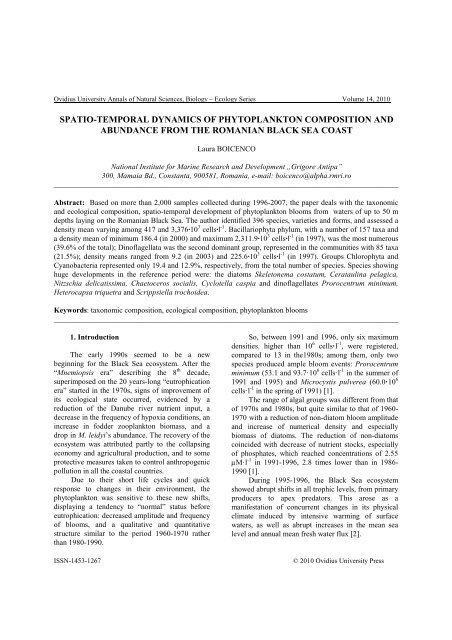VOLUM OMAGIAL - Facultatea de Ştiinţe ale Naturii şi Ştiinţe Agricole
VOLUM OMAGIAL - Facultatea de Ştiinţe ale Naturii şi Ştiinţe Agricole
VOLUM OMAGIAL - Facultatea de Ştiinţe ale Naturii şi Ştiinţe Agricole
Create successful ePaper yourself
Turn your PDF publications into a flip-book with our unique Google optimized e-Paper software.
Ovidius University Annals of Natural Sciences, Biology – Ecology Series Volume 14, 2010<br />
SPATIO-TEMPORAL DYNAMICS OF PHYTOPLANKTON COMPOSITION AND<br />
ABUNDANCE FROM THE ROMANIAN BLACK SEA COAST<br />
Laura BOICENCO<br />
National Institute for Marine Research and Development „Grigore Antipa”<br />
300, Mamaia Bd., Constanta, 900581, Romania, e-mail: boicenco@alpha.rmri.ro<br />
__________________________________________________________________________________________<br />
Abstract: Based on more than 2,000 samples collected during 1996-2007, the paper <strong>de</strong>als with the taxonomic<br />
and ecological composition, spatio-temporal <strong>de</strong>velopment of phytoplankton blooms from waters of up to 50 m<br />
<strong>de</strong>pths laying on the Romanian Black Sea. The author i<strong>de</strong>ntified 396 species, varieties and forms, and assessed a<br />
<strong>de</strong>nsity mean varying among 417 and 3,376∙10 3 cells∙l -1 . Bacillariophyta phylum, with a number of 157 taxa and<br />
a <strong>de</strong>nsity mean of minimum 186.4 (in 2000) and maximum 2,311.9∙10 3 cells∙l -1 (in 1997), was the most numerous<br />
(39.6% of the total); Dinoflagellata was the second dominant group, represented in the communities with 85 taxa<br />
(21.5%); <strong>de</strong>nsity means ranged from 9.2 (in 2003) and 225.6∙10 3 cells∙l -1 (in 1997). Groups Chlorophyta and<br />
Cyanobacteria represented only 19.4 and 12.9%, respectively, from the total number of species. Species showing<br />
huge <strong>de</strong>velopments in the reference period were: the diatoms Skeletonema costatum, Cerataulina pelagica,<br />
Nitzschia <strong>de</strong>licatissima, Chaetoceros socialis, Cyclotella caspia and dinoflagellates Prorocentrum minimum,<br />
Heterocapsa triquetra and Scrippsiella trochoi<strong>de</strong>a.<br />
Keywords: taxonomic composition, ecological composition, phytoplankton blooms<br />
__________________________________________________________________________________________<br />
1. Introduction<br />
The early 1990s seemed to be a new<br />
beginning for the Black Sea ecosystem. After the<br />
“Mnemiopsis era” <strong>de</strong>scribing the 8 th <strong>de</strong>ca<strong>de</strong>,<br />
superimposed on the 20 years-long “eutrophication<br />
era” started in the 1970s, signs of improvement of<br />
its ecological state occurred, evi<strong>de</strong>nced by a<br />
reduction of the Danube river nutrient input, a<br />
<strong>de</strong>crease in the frequency of hypoxia conditions, an<br />
increase in fod<strong>de</strong>r zooplankton biomass, and a<br />
drop in M. leidyi’s abundance. The recovery of the<br />
ecosystem was attributed partly to the collapsing<br />
economy and agricultural production, and to some<br />
protective measures taken to control anthropogenic<br />
pollution in all the coastal countries.<br />
Due to their short life cycles and quick<br />
response to changes in their environment, the<br />
phytoplankton was sensitive to these new shifts,<br />
displaying a ten<strong>de</strong>ncy to “normal” status before<br />
eutrophication: <strong>de</strong>creased amplitu<strong>de</strong> and frequency<br />
of blooms, and a qualitative and quantitative<br />
structure similar to the period 1960-1970 rather<br />
than 1980-1990.<br />
So, between 1991 and 1996, only six maximum<br />
<strong>de</strong>nsities, higher than 10 6 cells·l -1 , were registered,<br />
compared to 13 in the1980s; among them, only two<br />
species produced ample bloom events: Prorocentrum<br />
minimum (53.1 and 93.7·10 6 cells·l -1 in the summer of<br />
1991 and 1995) and Microcystis pulverea (60.0·10 6<br />
cells·l -1 in the spring of 1991) [1].<br />
The range of algal groups was different from that<br />
of 1970s and 1980s, but quite similar to that of 1960-<br />
1970 with a reduction of non-diatom bloom amplitu<strong>de</strong><br />
and increase of numerical <strong>de</strong>nsity and especially<br />
biomass of diatoms. The reduction of non-diatoms<br />
coinci<strong>de</strong>d with <strong>de</strong>crease of nutrient stocks, especially<br />
of phosphates, which reached concentrations of 2.55<br />
µM·l -1 in 1991-1996, 2.8 times lower than in 1986-<br />
1990 [1].<br />
During 1995-1996, the Black Sea ecosystem<br />
showed abrupt shifts in all trophic levels, from primary<br />
producers to apex predators. This arose as a<br />
manifestation of concurrent changes in its physical<br />
climate induced by intensive warming of surface<br />
waters, as well as abrupt increases in the mean sea<br />
level and annual mean fresh water flux [2].<br />
ISSN-1453-1267 © 2010 Ovidius University Press





